NVIDIA's GeForce GTX 570: Filling In The Gaps
by Ryan Smith on December 7, 2010 9:00 AM ESTPower, Temperature, & Noise
Last but not least as always is our look at the power consumption, temperatures, and acoustics of the GTX 570. While NVIDIA’s optimizations to these attributes were largely focused on bringing the GTX 480’s immediate successor to more reasonable levels, the GTX 570 certainly stands to gain some benefits too.
Starting with VIDs, we once again only have 1 card so there’s not too much data we can draw. Our GTX 570 sample has a lower VID than our GTX 580, but as we know NVIDIA is using a range of VIDs for each card. From what we’ve seen with the GTX 470 we’d expect the average GTX 570 VID to be higher than the average GTX 580 VID, as NVIDIA is likely using ASICs with damaged ROPs/SMs for the GTX 570, along with ASICs that wouldn’t make the cut at a suitable voltage with all functional units turned on. As a result the full power advantage of lower clockspeeds and fewer functional units would not always be realized here.
| GeForce GTX 500 Series Voltages | |||||
| Ref 580 Load | Asus 580 Load | Ref 570 Load | Ref 570 Idle | ||
| 1.037v | 1.000v | 1.025v | 0.912v | ||
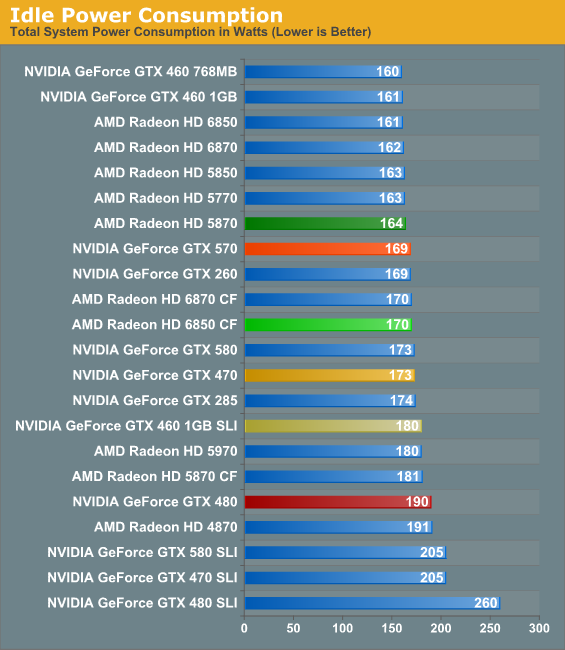
With fewer functional units than the GTX 580 and a less leaky manufacturing process than the GTX 400 series, the GTX 570 is the first GF1x0 card to bring our test rig under 170W at idle. NVIDIA’s larger chips still do worse than AMD’s smaller chips here though, which is driven home by the point that the 6850 CF is only drawing 1 more watt at idle. Nevertheless this is a 4W improvement over the GTX 470 and a 21W improvement over the GTX 480; the former in particular showcases the process improvements as there are more functional units and yet power consumption has dropped.
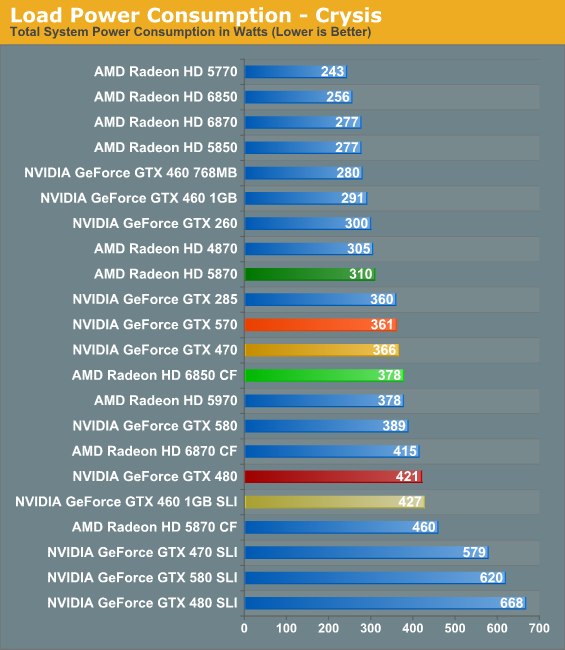
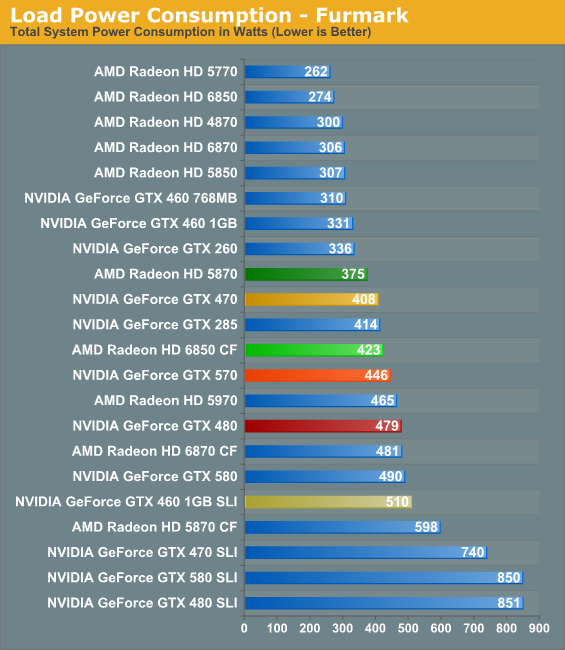
Under load we once again see NVIDIA’s design and TSMC’s process improvements in action. Even though the GTX 570 is over 20% faster than the GTX 470 on Crysis, power consumption has dropped by 5W. The comparison to the GTX 480 is even more remarkable at a 60W reduction in power consumption for the same level of performance, a number well in excess of the power savings from removing 2 GDDR5 memory chips. It’s quite remarkable how a bunch of minor changes can add up to so much.
On the flipside however we have the newly reinstated FurMark, which we can once again use thanks to W1zzard of TechPowerUp’s successful disabling of NVIDIA’s power throttling features on the GTX 500 series. We’ve rebenched the GTX 580 and GTX 580 SLI along with the GTX 570, and now have fully comparable numbers once more.
It’s quite interesting that while the GTX 570 does so well under Crysis, it does worse here than the GTX 470. The official TDP difference is in the GTX 470’s favor, but not to this degree. I put more stock in the Crysis numbers than the FurMark numbers, but it’s worth noting that the GTX 570 can at times be worse than the GTX 470. However also take note of the fact that the GTX 570 is still beating the GTX 480 by 33W, and we’ve already established the two have similar performance.
Of course the stand-outs here are AMD’s cards, which benefit from AMD’s small, more power efficient chip designs. The Radeon HD 5870 draws 50W+ less than the GTX 570 in all situations, and even the 6850 CF wavers between being slightly worse and slightly better than the GTX 570. With the architecture and process improvements the GTX 570’s power consumption is in line with historically similar cards, but NVIDIA still cannot top AMD on power efficiency.
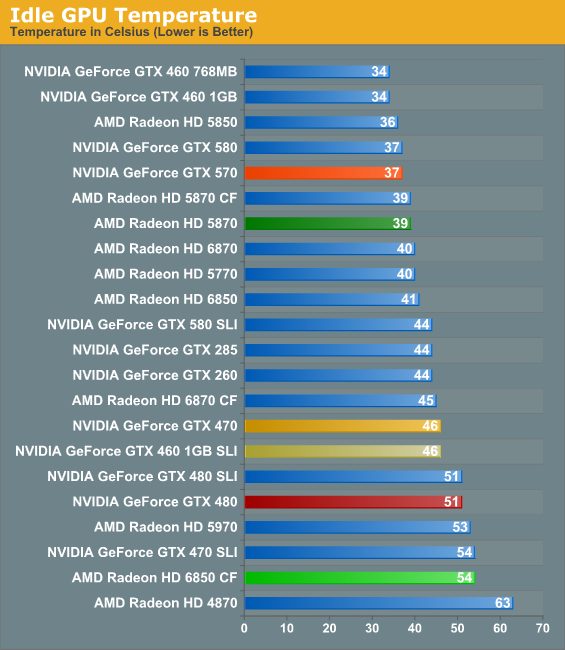
Up next are idle temperatures. With nearly identical GPUs on an identical platform it should come as little surprise that the GTX 570 performs just like a GTX 580 here: 37C. The GTX 570 joins the ranks among some of our coolest idling high-end cards, and manages to edge out the 5870 while clobbering the SLI and CF cards.
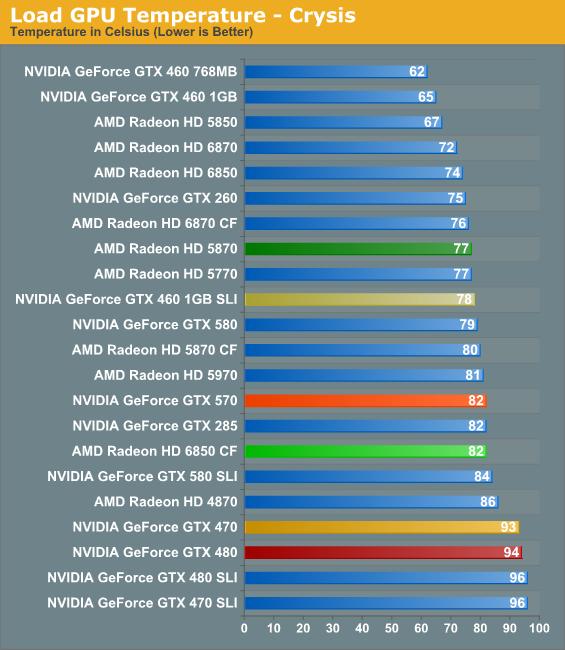
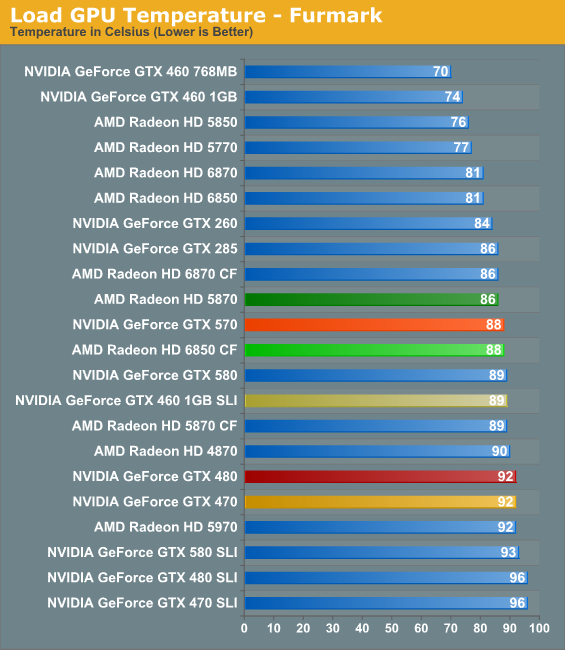
With the same cooling apparatus as the GTX 580 and lower power consumption, we originally expected the GTX 570 to edge out the GTX 580 in all cases, but as it turns out it’s not so simple. When it comes to Crysist the 82C GTX 570 is 3C warmer than the GTX 580, bringing it in line with other cards like the GTX 285. More importantly however it’s 11-12C cooler than the GTX 480/470, driving home the importance of the card’s lower power consumption along with the vapor chamber cooler. Is does not end up being quite as competitive with the 5870 and SLI/CF cards however, as those other setups are between 0C-5C cooler.
As for FurMark, temperatures approach the mid-to-upper 80s, putting it in good company of most other high-end cards. The 5870 edges out the GTX 570 by 2C, while everything else is as warm or warmer. The GTX 480/470 in particular end up being 4C warmer, and as we’ll see a good bit louder.
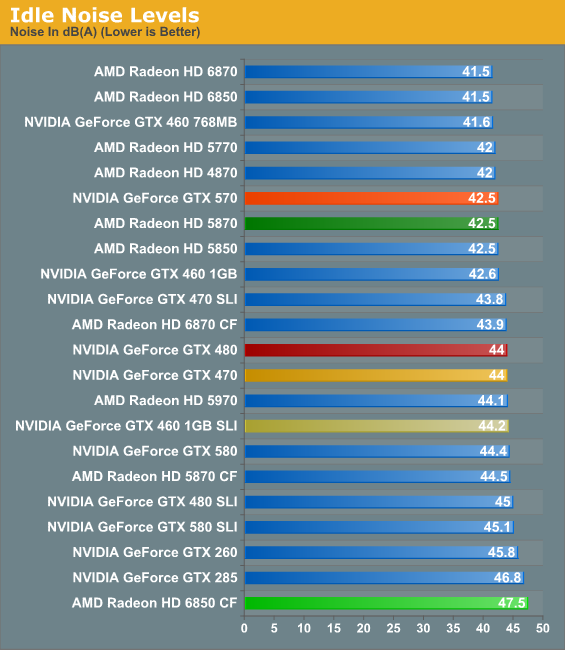
It’s once we look at our noise data that it’s clear NVIDIA has been tinkering with the fan parameters of their design for the GTX 570, as the GTX 570 doesn’t quite match the GTX 580 here. When it comes to idle noise for example the GTX 570 manages to just about hit the noise floor of our rig, emitting 1.5dB less noise than the GTX 580/480/470. For the purposes of our testing, it’s effectively a silent card at idle in our test rig.
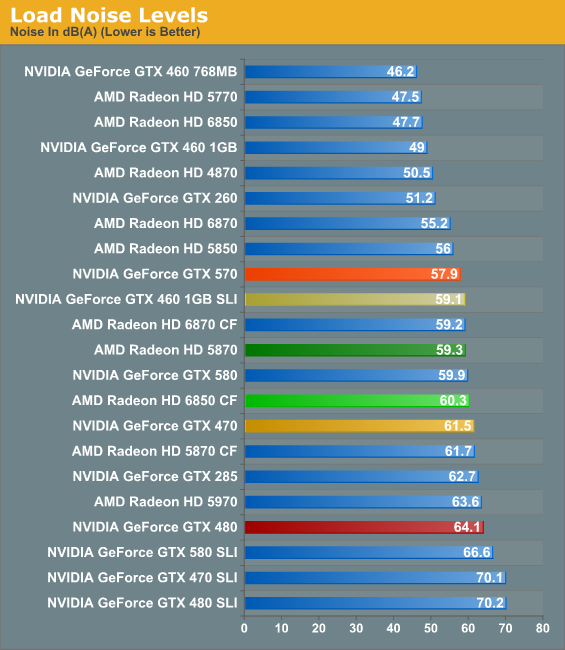
Under load, it’s finally apparent that NVIDIA has tweaked the GTX 570 to be quieter as opposed to cooler. For the slightly higher temperatures we saw earlier the GTX 570 is 2dB quieter than the GTX 580, 3.6dB quieter than the GTX 470, and 6.2dB quieter than the similarly performing GTX 480. For its performance level the GTX 570 effectively tops the charts here – the next quietest cards are the 5850 and 6870, a good pedigree to be compared to. On the other side of the chart we have the 5870 at 1.4dB louder, and the SLI/CF cards at anywhere between 1.2dB and 2.4dB louder.










54 Comments
View All Comments
Oxford Guy - Wednesday, December 8, 2010 - link
Does Nvidia not want people to use Unigine since it showed the 480 beating the pants off the 580 in minimum frame rate at 1920x1200 and lower resolutions?I've noticed a definite lack of Unigine on review sites for the 570.
stangflyer - Tuesday, December 7, 2010 - link
Any idea why the 580 sli takes such a huge dump going from 1920 res to the 2560 res. It loses half its framerate! I has 1.5 gigs of memory vs the 5870 1 gig and the 5870 crossfire goes from 50 fps at 1920 and 37 at 2560. The 580 sli goes from 72 fps at 1920 to 36 at 2560.Any ideas??
SmCaudata - Tuesday, December 7, 2010 - link
It seems that AMD is finally getting cross-fire scaling well. The new 68xx cars are better than the old, but the 5870 is scaling as well as the Nvidia cards in a lot of cases. My guess is that with cross-fire or SLI the memory bandwidth is less of an issue. You don't fully double your framerate afterall. It is likely more dependant on the GPU clock speed..which is an advantage for AMD.I am really just taking a guess here. The other option is that it is simply an immature driver and will be fixed later.
nitrousoxide - Wednesday, December 8, 2010 - link
Only when you used a dual-AMD-card configuration you will realize how much you will suffer from its poor drivers. It's fast but buggy and I've been waiting too long for AMD to finally come up with a Catalyst that at least runs as stable as the nVidia driver. So please AMD, give us a nice driver!Anchen - Tuesday, December 7, 2010 - link
Hey,Good review overall for an apples to apples comparison. I would have liked to see what it did overclocked as some have mentioned. On the Metro 2033 page the article says the following:
"While Metro was an outstanding game for the GTX 580 to show off its performance advantage, the situation is quite different for the GTX 470. Here it once again fulfills its role as a GTX 480 replacement, but it’s far more mortal when it comes to being compared to other cards. "
In the first sentence shouldn't it be "...the situation is quite different for the GTX570." and not the 470?
sanityvoid - Tuesday, December 7, 2010 - link
Much as I love this site, the color schemes for the charts is really getting old. Why can't all the colors be the same EXCEPT for the one being reviewed. We're mostly all adults and can read so the other GPU's in the charts could be left all one color.Some other sites do this and it is much easier to read what is actually being reviewed, even if the review color is always the same on each chart. It still adds to the clutter of the charts. The human eye/brain gets distracted easy.
Other than that, another good job on the article.
Ryan Smith - Wednesday, December 8, 2010 - link
Thanks for the feedback.The colors are still a work in progress. We had some requests for additional colors in GPU articles to highlight the products we're immediately comparing the reviewed product to, which is what I did for this article. Certainly if you guys this this is too much, we can go back to fewer colors.
ATimson - Wednesday, December 8, 2010 - link
Personally, my problem isn't so much that there are other colors, as that there's no good way to tell what they mean.Maybe one color for "other cards with benchmarks", one color for "immediate competition" (instead of each their own color), and a third for the product proper?
sanityvoid - Thursday, December 9, 2010 - link
I really like this idea. All one color for 'set' of reviews (if multiple), and one color for primary.BTW, I didn't know others were asking for more colors. I guess do what others want. For me, personally, I like the one color for primary and one color for all others. It is just the easiest for 'first glance' to be easily distinguishable.
Peace.
kirankowshik - Wednesday, December 8, 2010 - link
I dont know why I should go for the Nvidia GTX 580 / 570 series when I am getting the same (almost or more than) performance with ATI Radeon cards for a lower price. ATI HD 5970 is almost 30$ cheaper than GTX 580 but outperforms it in every single test. 5870 is not very close but atleast some what close and the performance of GTX 570 over 5870 does not justify a $100 gap between these two. Anyways, I think NVIDIA is just producing cards for name sake..with HD6900 series coming up, I will not be surprised if they offer huge performance leap over the GTX 580/570 for the same price...Again it will be what NVIDIA was when ATI released their batch of first DX11 cards and NVIDIA was struggling hard to get an answer to those...